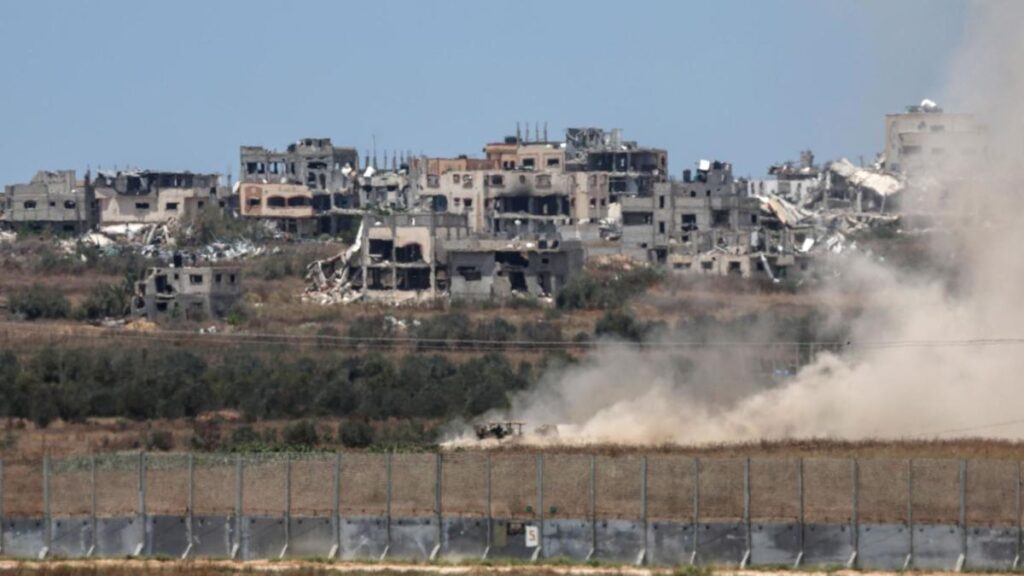The Israeli military reports that Palestinian armed groups in Gaza have fired about 20 rockets at Israeli border communities. It is the most serious attack in months.
A number of projectiles were intercepted and others landed in southern Israel, but no injuries were reported. The army said it responded with artillery fire.
Palestinian Islamic Jihad (PIJ) said it launched the barrage in response to Israeli “crimes.”
The attack came amid five days of heavy fighting in Shejaiya, northern Gaza, and an Israeli soldier was killed in the southern area of Rafah.
Israel’s prime minister said Sunday that his forces are engaged in a “difficult battle” across the Palestinian territory.
The Israeli military launched a campaign to destroy Hamas in response to an unprecedented attack on southern Israel on October 7, which killed some 1,200 people and took 251 hostage.
More than 37,900 people have been killed since then, including 23 in the past 24 hours, according to the Hamas-run Health Ministry in Gaza.
On Monday morning, sirens sounded in Israeli communities near the Gaza border fence, many of which have been evacuated since the October 7 attack.
The Eshkol Regional Council later reported that 18 rockets had been fired into the areas it administers, according to the Jerusalem Post. Most landed in open areas, but one fell “in the area of the Kibbutz Holit fence,” the report said. Another missile was intercepted by the Iron Dome missile defense system, the report added.
The Times of Israel reported that Monday’s barrage was the largest barrage from Gaza since Januarywhen at least 25 rockets were fired at the town of Netivot.
The Israeli Defense Forces (IDF) said the latest rocket fire came from the southern Khan Younis area and that its artillery had hit the sources.
The Palestinian news agency Wafa reported that artillery strikes on Monday killed one civilian and wounded several others in the town of Khuzaa, southeast of the city of Khan Younis.
Israeli warplanes also attacked a street in Shejaiya, in eastern Gaza City, and an area north of the Nuseirat refugee camp, in central Gaza, the report said.
Hamas’ military wing, meanwhile, said its fighters had attacked two Israeli tanks armed with explosives in Shejaiya.
The IDF said in a statement that its forces had “eliminated numerous terrorists in close combat and recovered large quantities of weapons” during raids in Shejaiya. Airstrikes had killed about 20 others and destroyed weapons production and storage facilities in the area, it added.
Fighting has been raging there since Thursday, when Israeli forces withdrew from the area following what the IDF said was “intelligence indicating the presence of terrorists and terrorist infrastructure.”
Over the weekend, residents said the attack had left bodies in the streets, while the IDF said two Israeli soldiers had been killed during fighting in northern Gaza.
According to the UN agency for Palestinian refugees (UNRWA), the Israeli army had ordered some 80,000 people in Shejaiya and surrounding areas to evacuate and move south, but they were forced westwards because they could not pass through Israeli checkpoints in the Wadi Gaza area.
“The Israeli army has completely destroyed the neighborhood,” a woman from the neighboring Tuffah district told BBC Arabic’s Gaza Lifeline program.
“I fled with others when the shells rained down around us. We moved from one area to another until we managed to escape the neighborhood. But many residents were trapped and could not leave,” she added.
“We are experiencing hunger, fear, murder, displacement and utter destruction.”
Palestinian fighters have regrouped in several northern areas, which were the focus of the Israeli ground offensive in the first three months of the war.
Since early May, Rafah has been the focus of attention, and the IDF believes it has now degraded the capabilities of three of the four Hamas battalions in the city.
Some of the estimated 10,000 people still in the city told Reuters news agency that Israeli tanks had advanced further into western and central areas on Monday, a day after reportedly moving within 1km of the Mediterranean coast.
Meanwhile, the Israeli military announced that one of its soldiers was killed during fighting in southern Gaza on Monday.
No further details were released about the incident, but Hamas previously reported that its fighters had blown up a booby-trapped house in Rafah and then lured Israeli troops inside.
In another development, the head of Gaza City’s al-Shifa hospital was released on Monday after seven months in Israeli custody. Dr. Mohammad Abu Salmiya claimed he was tortured while in custody. Israel denies mistreating detainees.
On Sunday, Prime Minister Benjamin Netanyahu told a cabinet meeting that Israeli forces were operating “all over the Gaza Strip” and killing “dozens of terrorists” every day.
“This is a difficult battle that is being fought above ground, sometimes in hand-to-hand combat, and also underground,” he warned.
“We are determined to keep fighting until we achieve all our goals: eliminate Hamas, return all our hostages, ensure that Gaza never again poses a threat to Israel and return our residents safely to their homes,” he added.
Sam Rose, director of planning at UNRWA, told the BBC from the camp in Nuseirat that the humanitarian situation is becoming increasingly dire for Gaza’s 2.2 million residents, three-quarters of whom are displaced.
“People need water, people need health care. It’s getting hot here, it’s 35 degrees Celsius, the smell of sewage, the lack of solid waste management facilities, the area is essentially becoming a dumping ground (for waste),” he said.
“The fuel does not arrive in sufficient quantities through the border crossings. Without that, incubators can’t work, the wells can’t work… Doing the simplest things is a real struggle for everyone.”

